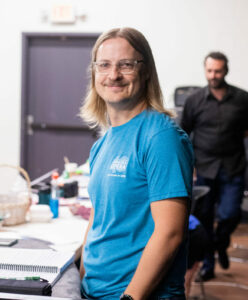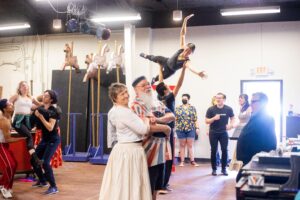View From the Pit
A look into the production process of Rodgers & Hammerstein’s Carousel from planning to the final curtain, through the lens of our Music Director Cody Martin.
Planning & Casting
Our process for Carousel began in the fall of 2021, when we were programming repertoire for our 40th Anniversary Season. As part of our leadership transition, this would be the first show that I planned alongside Corey McKern, Pensacola Opera’s newly appointed Artistic Director. We knew that we wanted to present a beloved musical, and we wanted it to be one that could be presented on a truly grand, operatic scale. Carousel was a perfect fit—especially once we discovered a beautiful production from Virginia Opera.
We completed all of our casting of the principal artists in early 2022, assembling an incredible group of talented singing actors, all of whom are primarily opera singers who have also done a good amount of musical theatre work. I had worked with Robert Wesley Mason on As One here in Pensacola in 2019, and I was actually a studio artist at Arizona Opera with Katrina Galka back in 2016! Besides the out of town principal singers—in addition to our 2022-23 Jan Miller Studio Artists—we also pulled from our wealth of local talent to fill out the rest of the cast, including UWF theatre professors Sara Schoch and Marci Duncan, and Joe Tomko, a professionally trained actor who previously taught at UWF as well.
Learning the Piece
Prior to our programming of Carousel at Pensacola Opera, I had actually never seen the show before! I knew all of the popular tunes of course—“If I Loved You,” “June is Bustin’ Out All Over,” “You’ll Never Walk Alone”—but I had a lot more music and dialogue to familiarize myself with.
My starting point with any production, whether it’s an opera or a musical, is to read through the libretto. For Carousel, I read both the Rodgers & Hammerstein version and the Ferenc Molnar play Liliom, upon which the musical is based. Reading through the text gives me a good feel for the story, characters, and themes of the piece, before I even start looking at the music. (If I were doing an opera in a foreign language, this is when I would also translate every sentence word-for-word. Thankfully, I get to skip this step when I do a piece in English!)
Once I was familiar with the text, I spent time with the piano/vocal score at the piano. As a conductor, I really benefit from this sort of “hands-on” approach to learning a piece. Playing and singing through the score really helps me to get everything into my ears and into my body. I also like to listen to recordings occasionally—not to really learn the piece, but to just get some ideas as to how other conductors have interpreted and conceptualized the music. There are numerous audio and video recordings of Carousel, spanning from the original Broadway production in 1945 all the way to the 2018 Broadway revival, so I had plenty of material to work with!
Auditioning & Rehearsing the Chorus
 Putting together a chorus is always one of my favorite parts of our opera season in Pensacola. Our chorus members are all volunteers who just love to sing! They work throughout the community as teachers, doctors, lawyers—you name it—and come together to rehearse and learn music, staging, and choreography over the course of weeks and months to become an integral part of each production.
Putting together a chorus is always one of my favorite parts of our opera season in Pensacola. Our chorus members are all volunteers who just love to sing! They work throughout the community as teachers, doctors, lawyers—you name it—and come together to rehearse and learn music, staging, and choreography over the course of weeks and months to become an integral part of each production.
We held auditions for Carousel in late November of 2022, and we were able to put together an incredible group of 26 chorus members. We began working on the music at the end of January, rehearsing for about five weeks to learn and memorize all of the songs they’re involved in. It is no small feat to memorize all of their music in such a short time, but as always, they rose to the occasion brilliantly.
Preparing Orchestra Parts
One of the most time consuming—and also one of the most important—tasks that I have to take care of for every production is prepping orchestra parts. Our amazing Pensacola Symphony musicians have their own busy performance schedules outside of our productions, so I need to make sure that any and all cuts are clearly marked, string parts are bowed, and copies are made and distributed well in advance of our first orchestra reads. The goal is to have any cuts, notes, or changes marked clearly enough that I can save time during rehearsals having to explain them! I received the Carousel parts in mid-January and distributed them to the players about a month later. This month of working on the parts also gave me plenty of time to become even more familiar with many of the orchestral intricacies throughout the piece.
Rehearsals with the Cast & Orchestra
After all of that is done, it’s finally time to start putting everything together! The cast and production team arrived in Pensacola the last week of February, and we had our first music and dialogue rehearsal on February 27. That first rehearsal is one of my favorites, getting to hear everybody sing together for the first time and building so much excitement for the weeks ahead.
 The next two weeks were spent in the room, learning all of the blocking and staging with the singers, chorus, and dancers.
The next two weeks were spent in the room, learning all of the blocking and staging with the singers, chorus, and dancers.
During this time, I conducted the rehearsals, working with our talented Studio Artist pianist, Nathan Cicero. This is our chance to figure out the flow and timing of the piece, how songs move in and out, and how we want the story to be paced along with the music. We also work on a lot of fine musical details during staging rehearsals—how to shape specific phrases, expressive ways to use particular consonants and sounds, and other things of that nature.
About a week into our official rehearsal period, I met with the orchestra for the first time. Our musicians from the Pensacola Symphony Orchestra are a group of top-notch professionals, so they’re able to read and learn music extremely well. They work with us on a wide variety of repertoire—everything from Mozart to musicals—and they always sound incredible doing it! We could not put on the productions we do without them, and I always look forward to meeting them in the orchestra pit at the Saenger. The orchestra for Carousel is definitely on the larger side for us; we even have an entire trombone section for this one—and a tuba!
Tech Week
As I write this retrospective, we’re about to head into the most important, yet rewarding, week of any production period: tech week. This is when we put everything together—singers, orchestra, lights, costumes, sets, makeup—and move onto the stage at the Saenger Theatre downtown.
We begin tech week with a sitzprobe, which is a German word for the rehearsal when the singers sing through the piece with the orchestra for the first time. This is my number one favorite rehearsal in any show, because it’s all about the music. The singers get to hear the orchestra for the first time, and vice versa, and we sing through the full score, working mainly on coordinating between all of the musicians—which for Carousel will be over 70 people.
Sitzprobe, Cody Martin conducts the Pensacola Symphony Orchestra for the Carousel Waltz.
In the theatre, we iron out all of the technical aspects of the show over the course of three tech/dress rehearsals. The first night, we rehearse with just a piano, so that we’re able to start and stop, repeat things as needed, or jump to a particular spot in the show. This is the chance for the crew to get used to all of the scene shifts, and for the singers to become familiar with the set and moving around on it. We add the orchestra for the second and third nights, when we’re able to run through the show from start to finish, adding all of the final touches. During these rehearsals, I am paying attention to balance between the singers on stage and the orchestra in the pit, usually with the assistance of somebody in the house who can listen for me. We also discover any spots where it may be difficult for the singer to catch me for an entrance, and we’re able to either adjust staging or figure out a different way to coordinate.
There is simply nothing like the energy in the theatre as the orchestra tunes, the house lights go down, the curtain goes up, and I give my downbeat for the first notes to be played by the orchestra. I love how I’m able to sense the audience behind me, knowing that they’re experiencing each performance for the first time.
- Cody Martin, Music Director
Performance Time!
All of this—close to 18 months’ worth of work—culminates in what everybody’s been waiting for: the performances! As a conductor, my performance day rituals are nothing too special or particular. I like to make sure I arrive at the theatre with plenty of time to sit, look through the score, and make sure everything is in place before the first downbeat. At Pensacola Opera, I also present a pre-show talk an hour before showtime. This is when I chat a little about the composer and librettist, the plot, and some of the musical intricacies to listen for in the performance.
After my talk, I make the rounds backstage to check in with all of the principals, the chorus, and stage management to make sure everybody is good to go and ready to perform. I may check some last-minute details with some of the principals, talking through specific moments and giving any final notes. Once I’ve seen everybody I need to see, I head back to my dressing room for a few final moments of silence before the fun begins.
There is simply nothing like the energy in the theatre as the orchestra tunes, the house lights go down, the curtain goes up, and I give my downbeat for the first notes to be played by the orchestra. I love how I’m able to sense the audience behind me, knowing that they’re experiencing each performance for the first time. Even if they’ve seen the piece before, they have never seen this performance with this combination of singers and production team. My final responsibility as a conductor—other than leading the performance and making sure everybody plays and sings where, when, and how they need to—is to savor each moment as it passes by, working with all of my colleagues to tell the story in a way that resonates with the audience. This is why I do what I do! I hope everybody who sees Carousel comes away from it having been moved in some way, by the power that only music brings.


